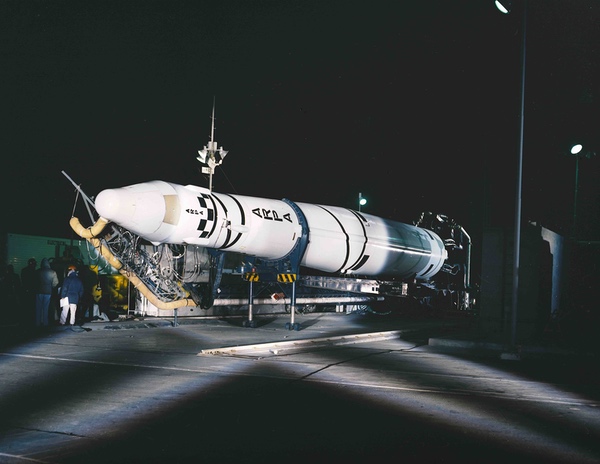 The Discoverer 3 launch vehicle preparing for launch in June 1959 at SLC-1 West. Discoverer was the cover story of the CORONA reconnaissance satellite program. This spacecraft carried mice that died before liftoff. (credit: Peter Hunter) |
By Dwayne A. Day
Monday, July 1, 2024
The Thor rocket served as the workhorse for American civilian and military space programs during the first decade of the space age, evolving into the Thor-Delta and eventually the venerable Delta II. Many launches took place from Vandenberg Air Force Base on the California coast, to deliver classified payloads into orbit. Relatively few photographs have been seen of these early Vandenberg operations because national security secrecy suppressed the story. Now, more images of Thor operations at Vandenberg have become available, offering a glimpse into what it was like to get the workhorse ready and launch it into space. (See “He little Rocket that could: Thor in the early days at Vandenberg (part 1)”, The Space Review, June 24, 2024.)
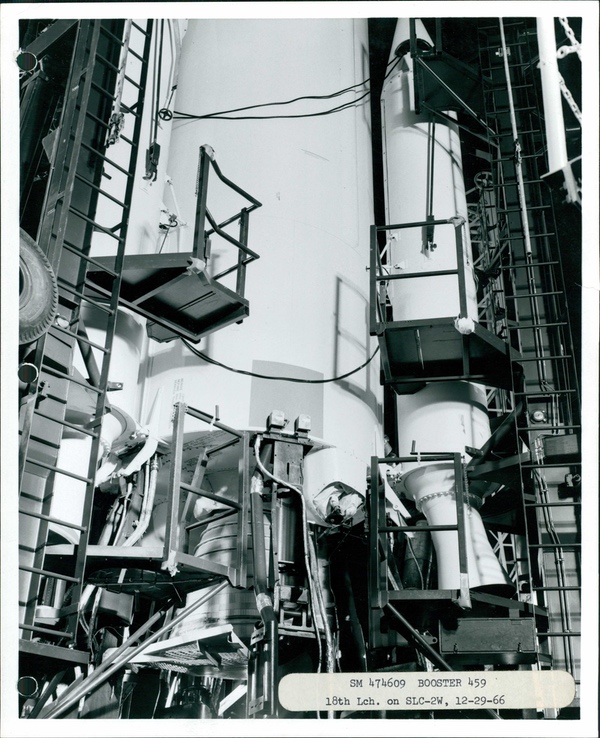 The business end of a Thor equipped with three solid rocket motors. This rocket was carrying a MULTIGROUP signals intelligence satellite. (credit: USAF) |
The legacy of Thor
In the space program, it has long been fashionable to claim “firsts” for every new achievement, sometimes to the point of absurdity. Naturally, the early rockets achieved many important “firsts,” and Thor racked up plenty of them:
- First operational American ballistic missile
- The first missile will be launched from Vandenberg Air Force Base
- First rocket to launch a spacecraft into polar orbit
- First rocket to launch a payload recovered from orbit
- First rocket to launch a reconnaissance satellite
- First rocket to launch a signals intelligence satellite
- First rocket to launch a communications satellite
- First rocket to launch a weather satellite
- First rocket to launch a navigation satellite
- First long-range vehicle that successively recorded 100, 200, 300 and 400 launches
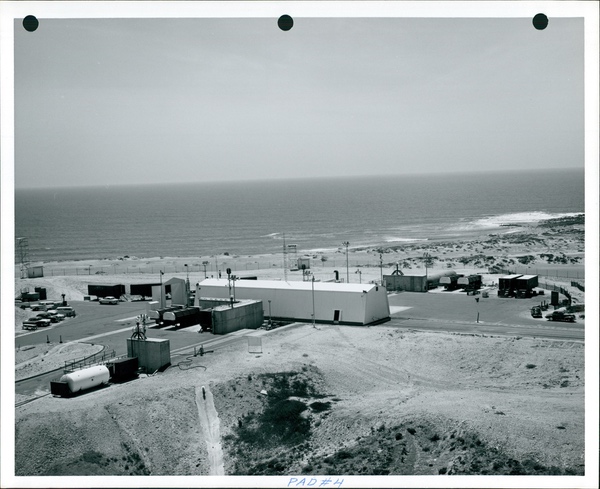 Space Launch Complex 1 West at Vandenberg Air Force Base in the 1960s. People who worked there encountered cold and windy conditions year-round. (credit: USAF) |
Many of these missions were launched into polar orbits from Vandenberg Air Force Base on the California coast, from relatively remote and simple launch sites such as Space Launch Complexes 1, 2, and 10. Simplicity was an evolution of Thor development: the first Thor launch facilities were built at Patrick Air Force Base in Florida to test the new intermediate-range ballistic missile. Partly because testing often involved lengthy pre-launch preparations, not to mention post-launch explosions, the Florida facilities were relatively rugged and heavy. In fact, during the first test launch in January 1957, Thor barely lifted off the pad before exploding. Major General Bernard Schriever, who was then in charge of American ballistic missile development, joked that the missile's accuracy was fine, they just needed to increase the range.
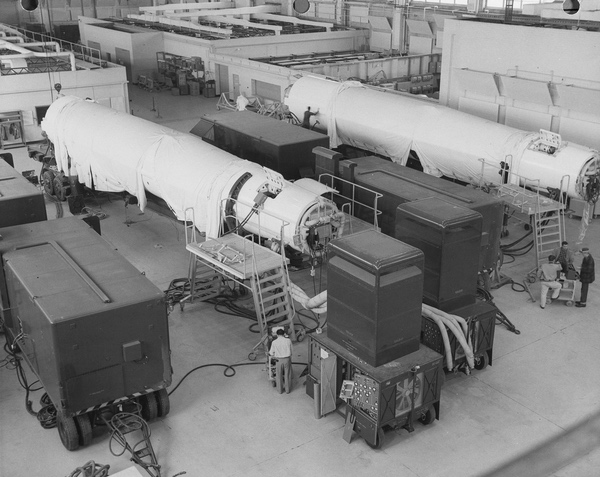 Preparations for launch of Thors, probably at Vandenberg. These are probably intermediate-range ballistic missiles of the Royal Air Force, which operated them in the UK, but conducted operational training launches at Vandenberg. (credit: USAF) |
Emily Project
When Vandenberg was founded, its facilities were built to handle operational, not test, Thor missiles, which required relatively less prelaunch work. Much of the equipment at the launch sites was identical to equipment designed to be airlifted to sites in Europe. Thor rockets and other support equipment were mounted on trailers that could be loaded onto Air Force cargo transports.
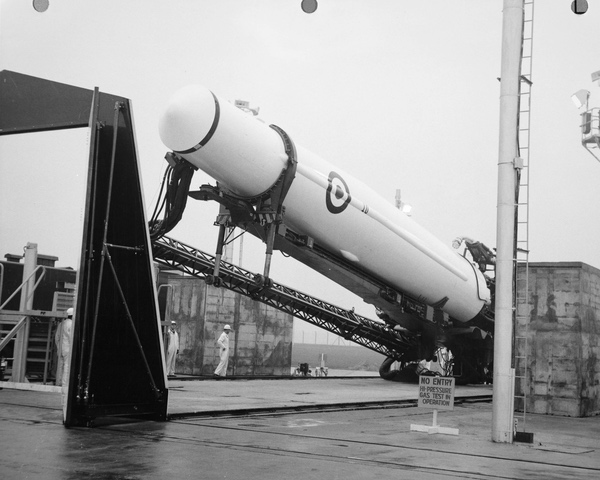 A Royal Air Force Thor prepares for launch in the UK. The RAF did not launch any of the missiles from the UK, but did train regularly. This platform is almost identical to those at Vandenberg. (credit: USAF) |
Between 1959 and 1963, the Royal Air Force operated 60 Thor intermediate-range ballistic missiles from 20 RAF airbases in the UK. This became known as Emily ProjectThe Thors were an important part of Britain's nuclear deterrent, although in an unusual arrangement the United States had operational control over the nuclear warheads. RAF Thor crews practiced launching nearly two dozen missiles from various sites at Vandenberg. When the program ended in 1963 and Britain decided to purchase polar Star Submarine-launched ballistic missiles, most of the RAF's Thors were returned to the United States and converted into launch vehicles.
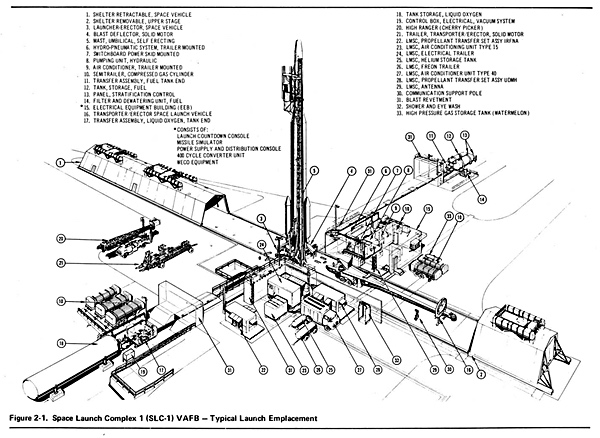 The SLC-1 pad at Vandenberg Air Force Base in the early 1960s. These pads were relatively austere, with most of the final processing of the rockets and payloads done horizontally in a retractable shed. Most of the pad's equipment was designed to be airlifted. (credit: USAF) |
Thor Standard Launch Vehicle
Although designed as a weapon, Thor was soon adapted for space launch, which would only take place from a few sites at Vandenberg. (See “Things that almost went boom” (The Space Review, June 17, 2024.) SLC-1, 2, and 10 served out most of their service lives with relatively spartan space support facilities. Most launch preparation was performed horizontally in retractable sheds, as were the missiles, and there were only limited payload servicing capabilities at the launch sites. SLC-2E eventually acquired a larger support pylon to replace the booster platforms used early in the program. SLC-2W received a much larger pylon to support NASA’s Thor-Delta program and its descendants, and to allow for vertical stacking of satellite payloads.
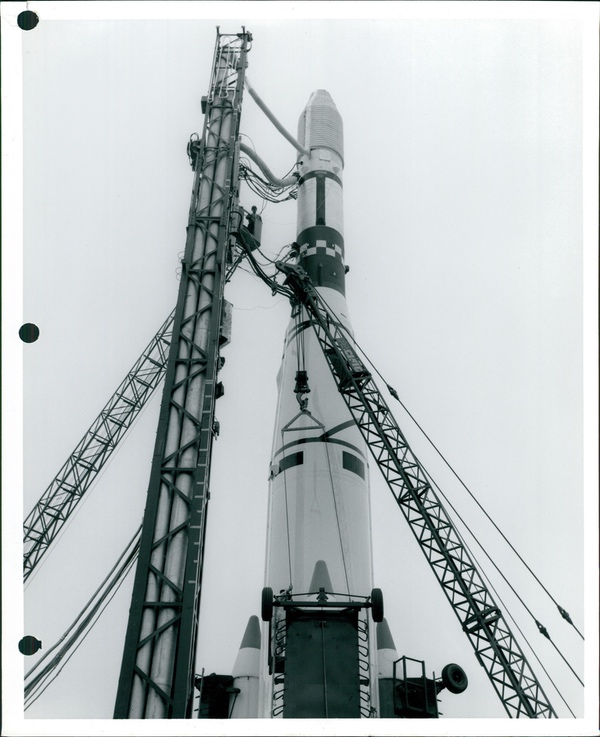 On early Thor launches, technicians reached the Agena upper stage and its payload using a lifting platform. (credit: USAF) |
In 1963, Thrust-Augmented-Thor Agena D rockets carrying the CORONA reconnaissance satellites were launched from the converted Atlas pad, initially designated PALC-1-1 but later renamed SLC-3W. SLC-3W had a flame trench, launch tower, and expanded support facilities, and CORONA launches continued from that site until the end of the program in 1972. After that, SLC-3W was again converted to support Atlas launches.
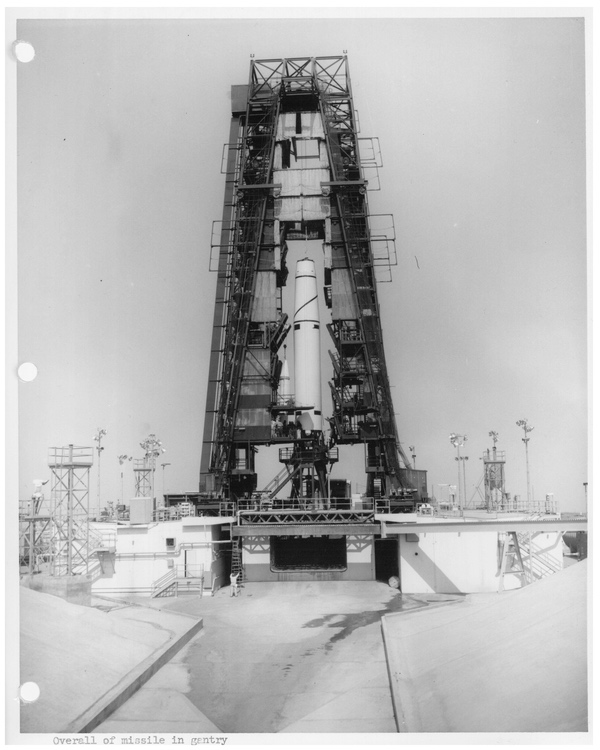 Although Thor launches began at SLC-1 and SLC-2, by the mid-1960s many were being flown from the converted Atlas pad at Space Launch Complex-3 West. The pad had a larger payload capacity. (credit: USAF) |
Thor rockets flew with a variety of upper stages over the years, including the Able I and II, the Ablestar, the Burner I and II, and the Agenas A, B, and eventually the D. The Agena D, like Thor, also earned a reputation as a versatile workhorse. Not only did it serve as a second stage, it also supported many payloads in orbit by providing stability, power, and communications. The Agena upper stages on top of Thors carried over a hundred CORONA reconnaissance satellites into orbit. They also carried over 100 CORONA reconnaissance satellites. A dozen large signals intelligence satellites with names like MULTIGROUP and STRAWMAN into space from Vandenberg until the early 1970s. Thor-Agenas launched other classified payloads such as the QUILL radar satellite and Program 989 Signals intelligence satellitesAgenas were also used on Atlas rockets on both coasts and on Titan rockets at Vandenberg, but the Thors at Vandenberg carried most of the Agenas to the edge of space, where the Agena took over.
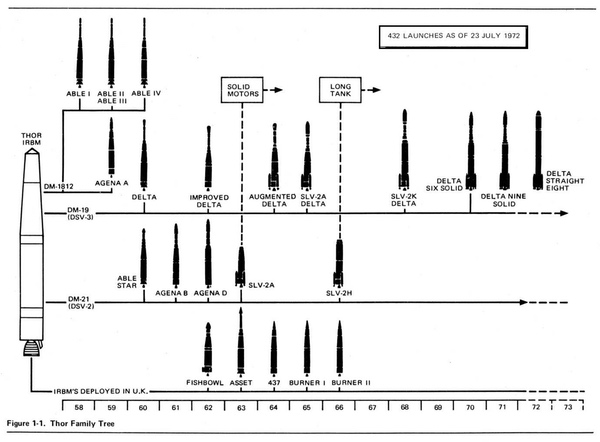 The Thor evolved into multiple variants, including several upper stages. For satellites that only needed a boost to orbit, but no power, stabilization, or communications, the Agena was unnecessary, leading to upper stages such as the Able I and II and Burner I and II. (credit: USAF) |
Thor fades away
The recently discovered Vandenberg Thor photograph collection includes few photographs of the payload, save for a few photographs of the launch of the Transit navigation satellite in 1963. (See “Nuclear Transit: Nuclear-Powered Navigation Satellites in the Early 1960s” The Space Review, February 12, 2024)
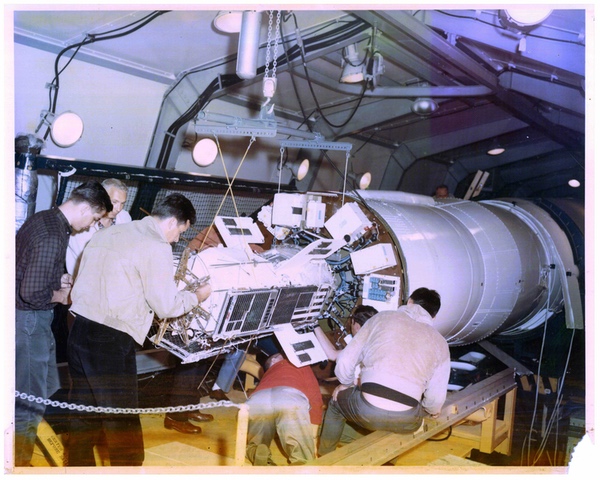 One of the Transit5BN navigation satellites being prepared for launch. Three such satellites were launched between December 1963 and April 1964 from Vandenberg. The last failed to reach orbit. (credit: USAF) |
Thor's record in its early years was not very good (that was true of all rockets in the early space age), but it improved rapidly over time to reach over 95% by the early 1970s. Still, there were notable launch accidents. Two of them involved nuclear power sources. In 1964, a Transit navigation satellite was launched from Vandenberg Air Force Base, It spread its radioactive material into the upper atmosphereIn 1968, a Nimbus weather satellite fell into the Santa Barbara Channel, just off Vandenberg. It was located by a search team, then lost, relocated, and recovered. The full story of that search and recovery effort Not fully reportedBut the most spectacular failure of the extended Thor family was a Delta II that exploded just above its launch pad in Florida in 1997, scattering debris over the surrounding scrubland and destroying the cars of the pad workers.
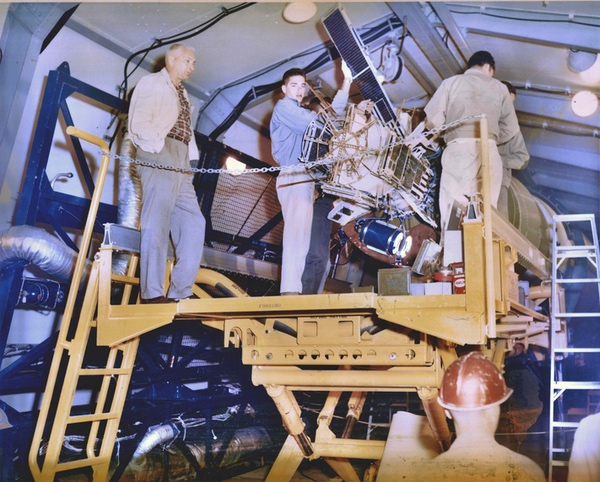 A Transit 5BN satellite being prepared for launch at Vandenberg. The satellite was nuclear-powered, using a small radioisotope thermoelectric generator (RTG) with about a kilogram of plutonium. (credit: USAF) |
Thor missiles and unflown launch vehicles are on display at several americans and British museums, and there’s a Thor inside a shed at the preserved SLC-10 launch site at Vandenberg Space Force Base. The last Delta II rocket ever built is on display outdoors at the Kennedy Space Center Visitor Center. The workhorse is long retired, fading from memory but not yet forgotten.
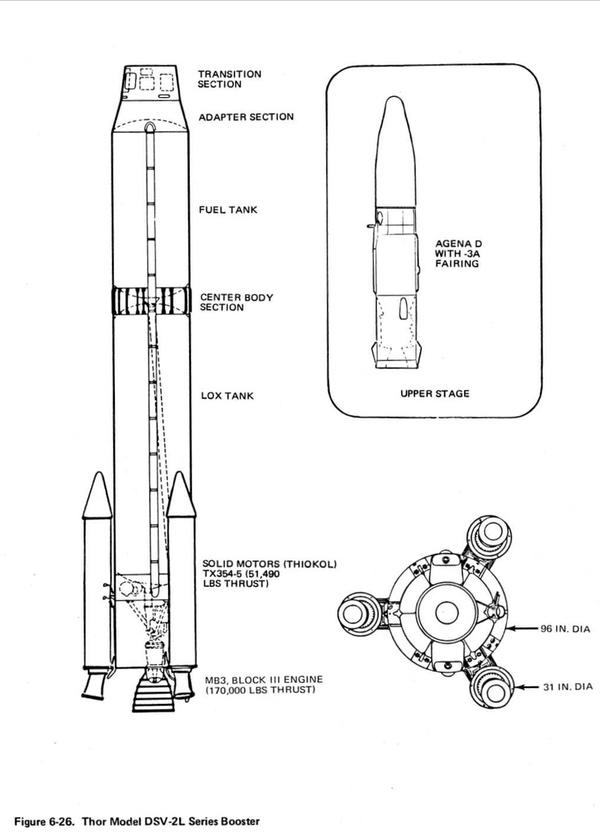 Thor rockets operated with several upper stages during their service, but the most common was the Agena, which also served as a spacecraft in low Earth orbit, supporting photo-reconnaissance and signals intelligence payloads. (credit: USAF) |
Next: Part 3, Thor Gallery.
Note: We are moderating comments. There will be a delay in posting comments and there is no guarantee that all submitted comments will be posted.













Leave feedback about this